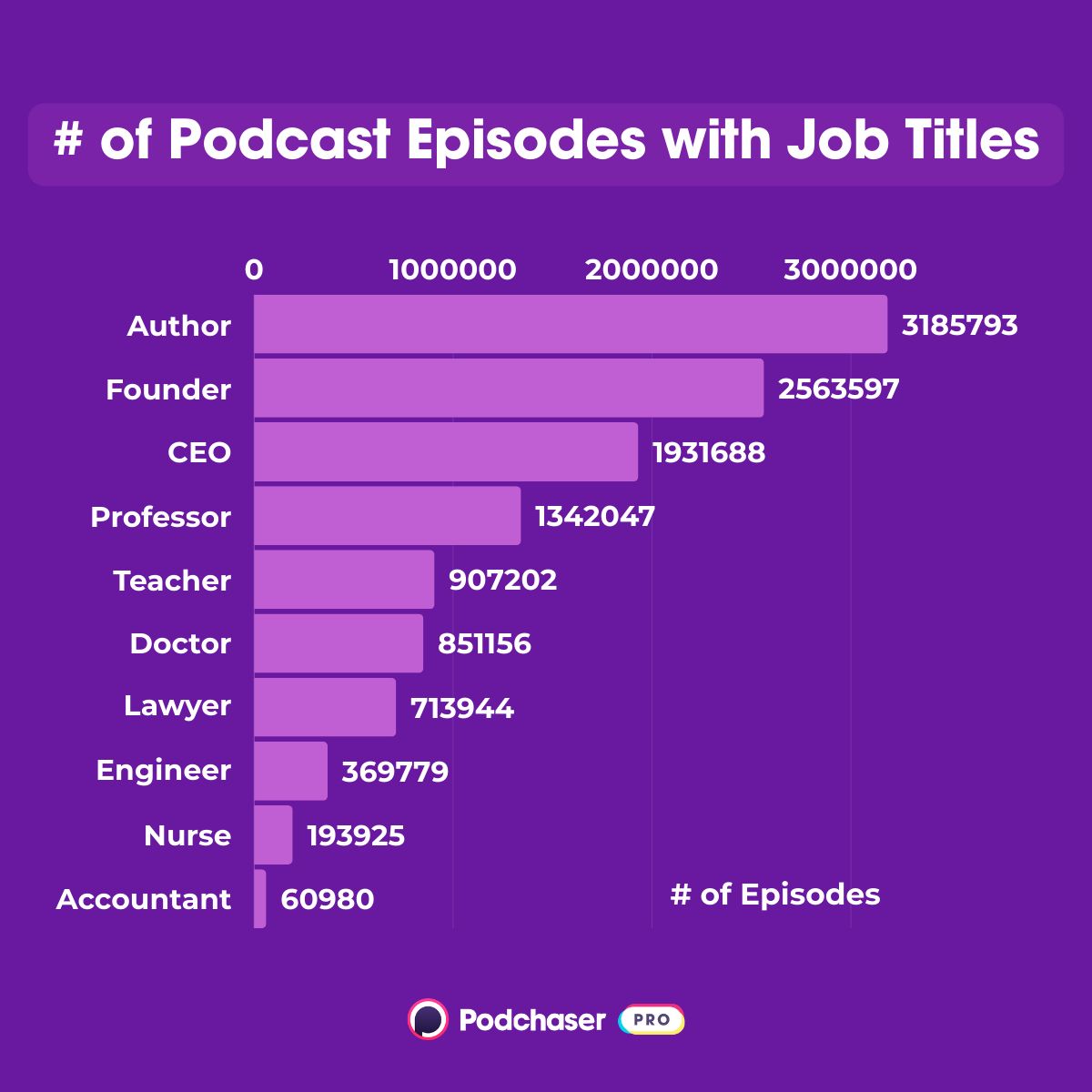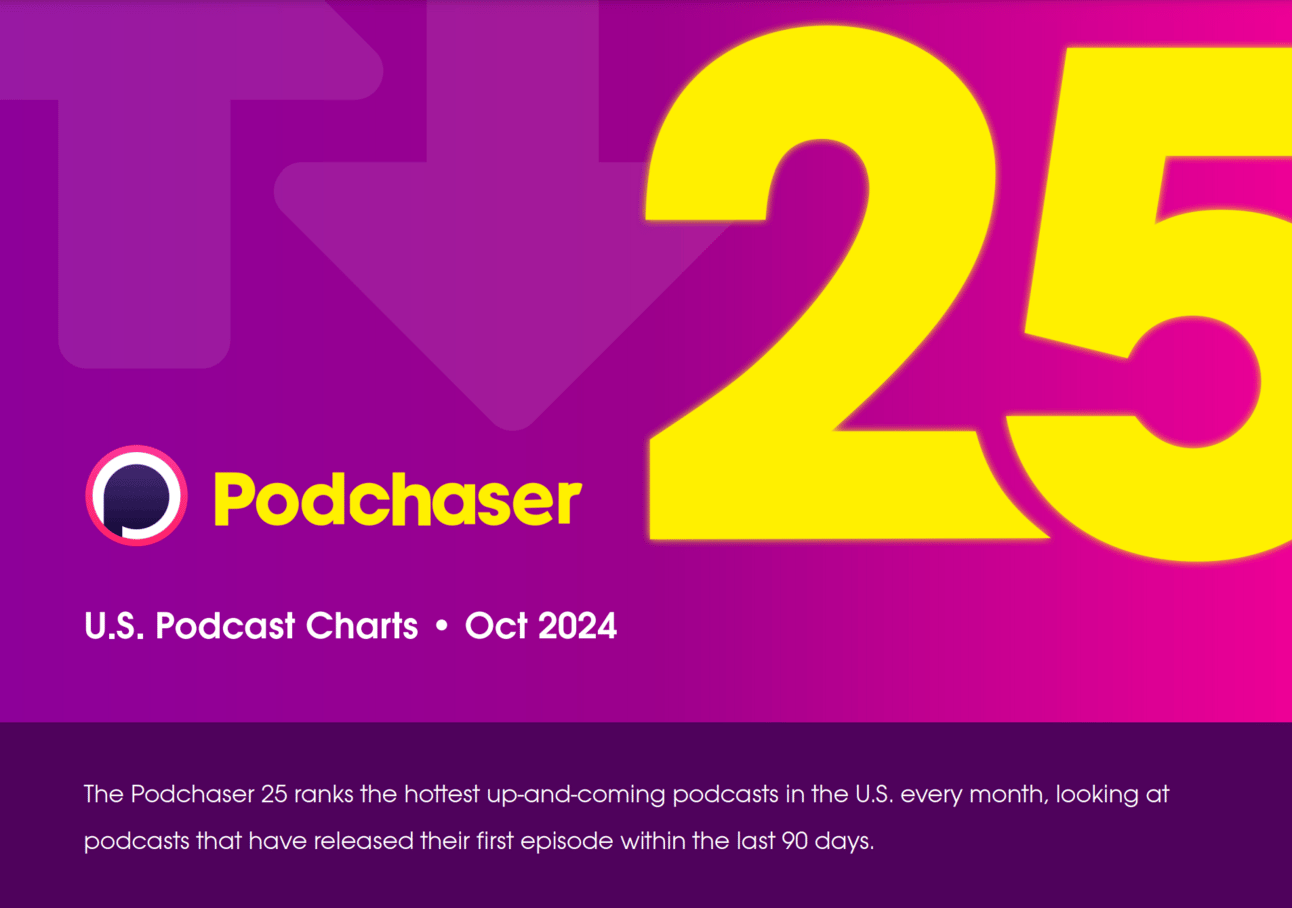- Podchaser Pulse
- Posts
- Podchaser 25, Podcast Episodes by Occupation, Audience Surveys that Work
Podchaser 25, Podcast Episodes by Occupation, Audience Surveys that Work
data story inside
Today's Lineup 🎙️
October’s Podchaser 25 dropped this week
The Podchaser 25 Snapshot
The Podchaser 25 showcases the hottest U.S. podcasts that debuted within the last 90 days. These rankings aren’t just about popularity; they reflect what’s buzzing across genres. Top titles like Kill List and Sidebar: A Suits Watch Podcast capture listeners with their mix of true crime, nostalgia, and in-depth commentary. Each podcast’s Power Score™—a unique metric based on listener data, social engagement, and chart positions—signals emerging audience favorites.
Takeaway: October’s rankings reveal a fresh appetite for crime mysteries and behind-the-scenes celebrity stories, hinting at what themes might dominate next.
Genre Trends - True Crime’s Unstoppable Rise
True crime podcasts continue to dominate, with seven out of the top 25 podcasts rooted in crime storytelling. Kill List, with a gripping look into dark web contract killings, claims the #1 spot. Podcasts like The Trial of Diddy and Law & Order: Criminal Justice System offer deeper dives into criminal cases with unique storytelling angles, highlighting a demand for real-world intrigue and complex narratives.
Nostalgia Meets New Formats - TV and Pop Culture Rewinds
Listeners love to revisit iconic moments, evident in Sidebar: A Suits Watch Podcast, where cast members Patrick J. Adams and Sarah Rafferty recap episodes and spill behind-the-scenes tales. This trend of “reminiscing with insiders” drives listener engagement, as audiences crave both familiarity and fresh takes. What Did You Do Yesterday?, capturing everyday stories with humor, taps into the power of simplicity in storytelling.
Takeaway: Rewind-style podcasts show there’s untapped potential in familiar stories reimagined, especially with celebrity hosts who connect with audiences.
Sports and Comedy in Unison - Breaking Through with Humor
From Heed the Call to Dudes on Dudes, sports-themed podcasts combine humor and insider insights, proving this blend is a hit formula. Hosts like Rob Gronkowski and Julian Edelman bring lighthearted banter to sports analysis, giving fans a personal peek into the lives of sports icons. Soccer A-Z, led by iconic British hosts, also spotlights the global appeal of funny, relatable sports commentary. Comedy creates a welcoming space for hardcore fans and casual listeners alike.
Takeaway: The fusion of comedy and sports attracts diverse listeners, suggesting more room for lighthearted, personality-driven content.
The Podchaser 25 is your pulse on the freshest, fastest-growing podcasts, highlighting the genres and voices listeners crave most right now. Want to see the full list? Get it below 👇️
Data: Podcast Episodes by Job Title/Occupation
Podcasting has become a powerful medium for sharing expertise across professions, with certain job titles attracting significant attention in podcast episodes. New data reveals that roles like "Author," "Founder," and "CEO" dominate in mentions, underscoring the appeal of leadership, storytelling, and entrepreneurial insights. Meanwhile, other professions, such as "Engineer" and "Accountant," are less commonly featured, presenting unique opportunities for niche voices to break through. For podcasters, PR professionals, and advertisers, understanding the popularity of various job titles in podcasts offers a roadmap for reaching targeted audiences and highlighting underrepresented perspectives.

Chart Insights: Podcast Episodes Featuring Job Titles
Top Titles: "Author" leads with over 3.1 million mentions, followed by "Founder" at 2.5 million and "CEO" at 1.9 million.
Academic Roles: "Professor" (1.3 million) and "Teacher" (907k) show strong representation, signaling interest in expert and educational perspectives.
Healthcare Presence: "Doctor" appears in 851k episodes, and "Nurse" in nearly 194k, indicating substantial podcast content in medical fields.
Legal & Technical Fields: "Lawyer" (713k) and "Engineer" (370k) highlight demand for legal and technical insights, though these ranks lower than executive roles.
Underrepresented Professions: "Accountant" has the fewest mentions (61k), suggesting a potential gap for niche voices in finance.
For Podcasters & PR Pros: High counts for "Author," "Founder," and "CEO" imply strong interest in storytelling, entrepreneurial, and leadership content. PR professionals might pitch clients in underrepresented fields, like accounting, to stand out.
For Advertisers: Episodes with high-ranking job titles provide targeted engagement opportunities—e.g., advertising B2B services in CEO-focused podcasts or educational tools in teacher-related episodes.
Running Audience Surveys to Deepen Podcast Audience Insights
Audience surveys are one of the most direct and effective ways to understand what your listeners value, where you can improve, and which directions may foster growth. Here’s a step-by-step guide on what to ask, how to analyze, and how to act on survey results.
What should you ask your audience?
A. Listener Demographics & Behavior
Start by understanding the basics of your audience:
Who are they? (Age, gender, location, job, hobbies)
How did they discover your podcast? (Social media, word of mouth, recommendation, etc.)
How frequently do they listen? (Every episode, occasionally, selectively)
Where do they listen? (At home, during commute, while exercising)
What else do they listen to? (opens opportunities to collaborate)
B. Content Preferences
This gives you insights into what resonates:
Favorite topics and episodes
Ask listeners to name their top episodes or topics.
Episode length preferences
Shorter (15-30 mins), medium (30-60 mins), longer (60+ mins)?
Guest preferences
Are there particular guests or types of expertise they want more of?
Topics they’d like to see covered
Include open-ended fields for new topic ideas directly from listeners.
C. Engagement & Community
Understand what could boost engagement:
Interest in community events
Would they participate in live Q&As, listener meetups, or discussion groups?
Feedback on current marketing
Ask if they follow you on social media, read your emails, and how they interact with your posts.
Suggestions for interaction
Ask how they’d like to engage more with you and the podcast (exclusive content, behind-the-scenes, etc.).
D. Constructive Criticism
Invite improvement-oriented feedback:
What could be improved?
Open-ended but focus on quality, content variety, or production.
Barriers to listening
What prevents them from tuning in more often? This could reveal opportunities to adjust scheduling, format, or platforms.
How to Analyze Survey Results
A. Segment Responses by Audience Groups
If you capture demographic data, analyze responses by key groups (e.g., age or location). Different segments might have unique preferences, allowing you to tailor episodes or marketing efforts for distinct audience niches.
B. Identify Trends and Patterns
Look for recurring responses, especially on favorite topics, preferred episode lengths, and common feedback points. For example, if multiple people request shorter episodes, consider testing a new episode length.
C. Prioritize Actionable Insights
Not all feedback will be feasible to act on. Focus on high-impact insights that align with your show’s goals:
Popular content requests for episodes or series.
Format or length adjustments that suit a majority preference.
Engagement opportunities like live events if there’s clear interest.
D. Quantify Open-Ended Responses
For qualitative responses, group similar answers and assign codes (e.g., multiple people requesting more industry experts as guests). This way, you can quantify open-ended feedback to see which ideas have the most support.
Putting Survey Results into Action
A. Adjust Content and Format
Test New Topics or Segments
If listeners suggest specific topics or guests, integrate these into upcoming episodes. If a large number want a specific theme, consider a dedicated series or segment.
Experiment with Episode Length
If there’s feedback favoring shorter or longer episodes, experiment with varied episode lengths for a period and monitor engagement.
B. Enhance Marketing & Engagement Efforts
Promote on Preferred Platforms
If listeners discovered you through a specific platform, increase your presence there. For example, if most found you on Instagram, invest more in Instagram stories or Reels.
Engage More with High-Interest Audiences
If a segment (e.g., younger listeners) shows high engagement potential, consider exclusive content or live events tailored to their interests.
C. Establish a Feedback Loop
Showcase Listener Contributions
Thank listeners for feedback, and consider sharing “listener-inspired” episode shout-outs or topics.
Regular Surveying
Periodically conduct mini-surveys after making adjustments, asking listeners if they noticed and appreciated the changes.
D. Measure Post-Survey Impact
After implementing changes, track your key metrics (downloads, listener retention, social media engagement) to measure if the adjustments improved engagement or growth.
Running audience surveys can transform your understanding of your listeners, allowing you to make informed decisions that resonate with their interests and needs. By structuring questions thoughtfully, analyzing data carefully, and implementing feedback meaningfully, you can create a show that keeps listeners engaged and accelerates your growth trajectory.
Want to see this data (and more) up close? Consider a Podchaser Pro subscription.
5.4M podcasts
Deep demographic data
Monthly and per episode reach
and so much more

